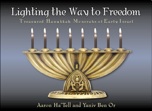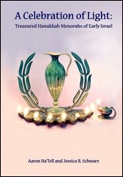BORIS GORBIS: I belong to a huge group of people to whom early Israel was denied by virtue of birth. Some were born too late to see it grow and mature. In my case, growing up in the Soviet Union, Israel was a taboo, a forbidden world.
Lighting Way To Freedom became a powerful source of knowledge and validation of my awakened interest in the pioneer days and first three decades of the Jewish State. Far from being a mere reference source, it introduced me to the previously unheard voices of artisans and designers, to their successes and failures.
This painstakingly restored universe was a visual map of major metal design efforts in the deciding decades of the survival of Jewish Palestine and Israel's existence. The book began as a labor of love for the beauty and power of individual creations. In reality, it became a celebration of the very source of Jewish spiritual and creative light.
It is now and shall always remain a pioneering work and for that alone we should be grateful to its author(s). New, previously unseen hanukkiot were discovered. It became clear that the first edition would need expansion. A second volume is now coming. Undoubtedly, there will be a third and a fourth that also include the variety of Israeliana made then. It is also clear that this effort opened largely unseen doors to collectors and historians. Because of the book's success, interest now expands to period creations in brass, silver, ceramics, wood and textile before they disappear through time and uncaring.
Looking at this period of Israeli creativity through the eyes of an American Jew, one can see the visual language of love rediscovered and celebrated in Lighting Way To Freedom. For new generations of Americans, the book recovered images coming from Israel into American collective psyche in the 50's, 60's and 70's. Their force remained neglected and even dismissed until this work was published. Tons of early Israeli metal-craft production -- Israeliana -- disappeared into dumpsters. Not any more.
Browse through the book and you shall discover archetypes of Life (woman with a jar of water) of Strength (the Maccabees), of Abundance (the spies), of Unity (The 12 Tribes), of Tradition (the Lion of Judah), of Joy (The Klezmers and the dancers).
These powerful images defined Israel to America and her self. Not war, not strife, not hostilities, not suffering but the positive images of the land and its strong and joyful people formed attitudes and guided actions of American Jews and non-Jews towards Eretz Israel.
We may never reconstruct the full text, but we could not visualize the love affair between early Israel and America without the "Lighting". We would not have become interested in the full artistic genius of Ruben Dayagi, Hans Teppich, Abraham Oppenheim, Maurice Askalon, Ludwig Wolpert and many others without the painstakingly assembled display of their hanukkiot.
I dream of the day when not only this book, but everything that stands behind it, from the history of its authors to their private collections, would become a destination point for learning for children and adults in Israel and America. There they will touch the Menorahs. They will discover authentic effort to give form to Jewish desires and aspirations.
The book alone cannot place Israel back on the creative map but together we can pay tribute to those who lit our way. It is with this hope in my heart that we can try to make it possible. I call upon all readers and collectors, to become allies, friends and supporters of this historic task.
Boris Gorbis
Founder, "AM-IS Museum"
Los Angeles, California, USA,
June, 2009
Copyright © 2010 Aaron Ha’Tell. All rights reserved.
Website Designed by Jessica Schwarz
The struggle for freedom is always!
Hundreds of beautiful photos tell the story of the rebirth of a free people...



